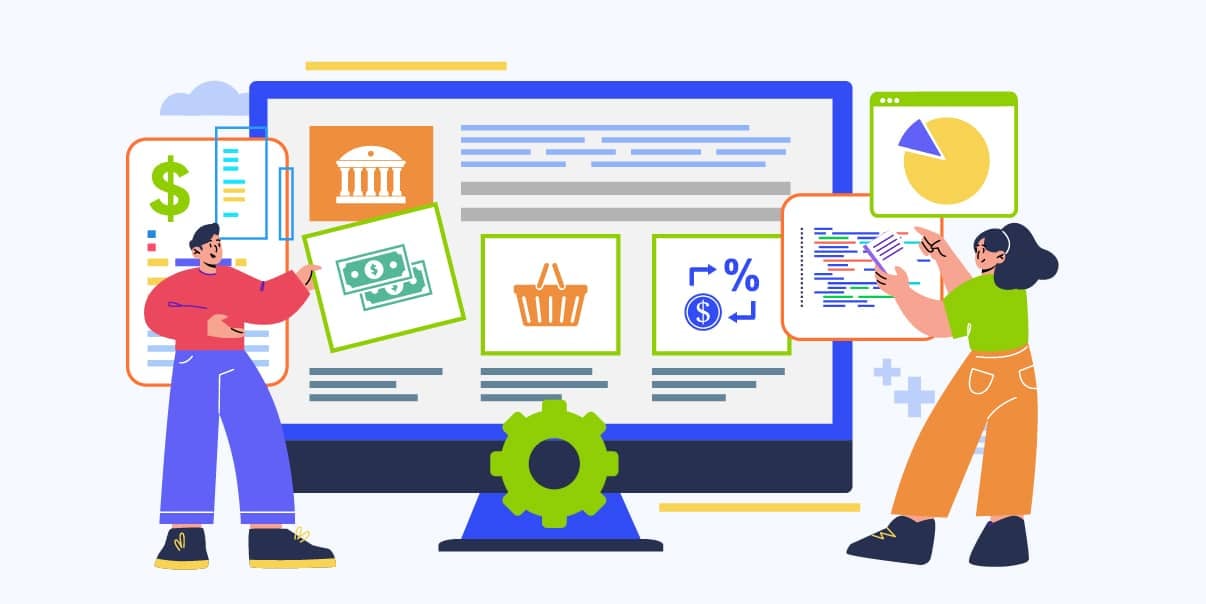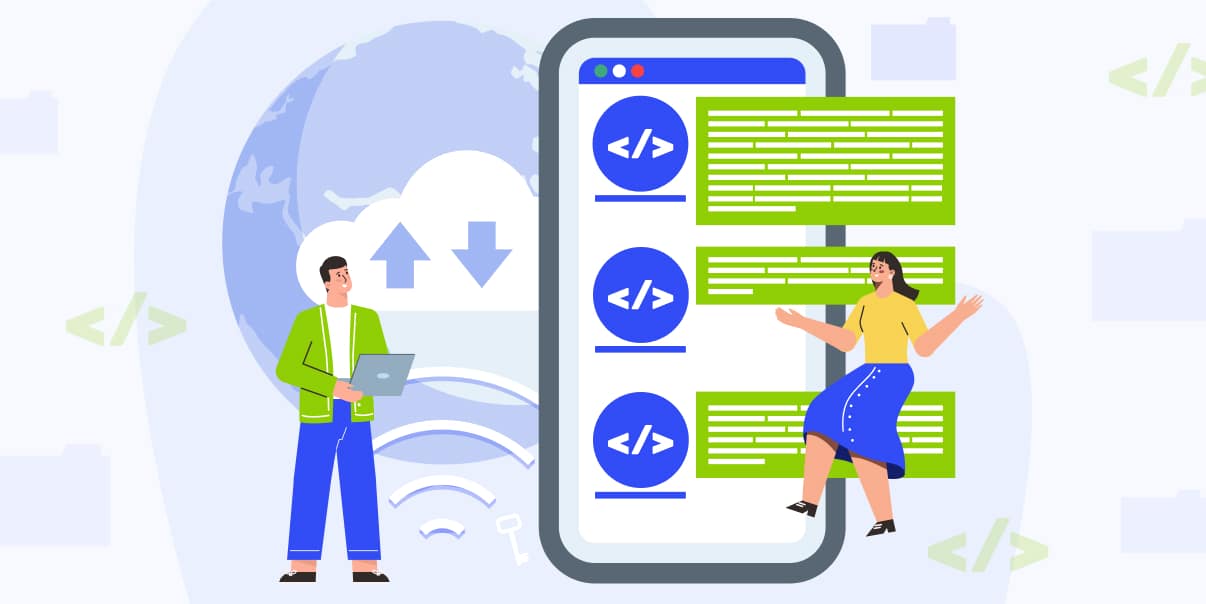What Is Open Banking API? A Complete Explainer

Open banking API helps companies streamline the management of payment and money transfer data online. This technology allows financial institutions to access financial data from multiple sources. By using an API, businesses can quickly and securely move money around. But what is open banking API, and how can it help your business?
This article will explain open banking APIs and how they work. It’ll also cover the benefits of using them, plus potential security risks and how to mitigate them.
Understanding Open Banking API
Before you use API banking, you must first understand its functions. It will help you determine if it is the right tool for your business. You will also have a better chance of using open banking APIs safely.
What Are APIs?
An API (application programming interface) acts like a server that connects different computer programs.
APIs are like the menu and order form in a restaurant. You choose what you want from the menu, fill out the order form, and hand it to the server. Similarly, an API provides a set of rules and protocols for programs to send requests and receive responses from other programs.
An app or website uses an API to send and receive information to and from other apps or systems. When you want to use another program’s services, you don’t directly go to the other program’s code. Instead, you will send your request to the API provider. It will transfer your command to another program. Then, it will bring the program’s response back to you.
In short, an API makes it easier for different programs to communicate and work together.
What is Open Banking API?
Now, you know how an API works. But what is open banking API?
Open banking APIs help financial institutions share customer data safely. In open banking, banks share their customers’ financial information with authorized third parties. It gives users access to money transfers and payment services.
Here’s how it works:
The Customer Gives Permission
A customer wants to share their banking information with another company. They give consent to the company to access their account information. For example, they can share how much money they have in their account or how they spend it.
The Other Company Gets The Information
Financial institutions use open banking to access customers’ data from their bank’s systems. This data can include a customer’s bank balance, recent transactions, and other account details. The API also allows third-party providers (TPPs) to initiate payments from the customer’s account.
The Other Company Uses The Information
Once the TPPs have the customer’s info, they can use it to offer personalized financial services. For example, they might offer the customer advice on how to save money or smartly invest their money.
The Bank and Customer Are in Control
Throughout the process, the bank and the customer control the information they share with other third parties. The bank can monitor the third party’s access to the customer’s data. They can stop third parties from accessing it at any time. Customers can also stop sharing their information if they want to.
Benefits of Open Banking API
Open banking offers various advantages for both consumers and financial institutions. One open banking APIs benefit is offering better customer engagement.
Let’s look at the other benefits:
Advantages for Financial Institutions
Financial institutions can use open banking APIs to provide customers with better services. Here are the benefits of using APIs.
- Customer Loyalty. Secure data sharing will increase customer loyalty. It will also help banks retain their existing customers.
- Transaction Accuracy. Banking APIs use secure systems to transfer information from one bank to another. It reduces manual issues that may occur during transactions.
- Fewer Costs. Open banking improves processes and reduces manual work. It helps financial institutions lower their operating costs.
Advantages for Consumers
Open banking also benefits consumers. With this technology, users can easily access their financial data online. It also offers convenience and helps users save time.
Here are the other open banking APIs benefits for consumers:
- Convenience. Open bank APIs allow consumers to access their banking information and services in one place. It helps them open financial apps without logging out to others.
- Financial Management. With APIs, consumers can access real-time information on their account balances. It can help them manage their finances, track their spending, and save money.
- Greater Control. Open bank APIs give consumers greater control over their financial data. They can share their data with third-party providers to get better financial insights. But they can also revoke access at any time.
- Personalized Experiences. Open bank APIs allow third-party providers to create customized products and services. For example, an app can recommend saving tips based on a user’s spending habits.
Advantages for Third-Party Providers
Open banking APIs also offer advantages for third-party service providers. It helps them access customer data and provide personalization.
Here’s what third-party providers can get from using open banking:
- Access to Banking Data. APIs allow service providers to access financial data without their infrastructure. It helps them create new products and services for finances.
- Speed. Open banking enables service providers to access data efficiently. They can develop products and services that are fast and responsive, giving users a better experience.
- Lower costs. APIs are often cheaper than building your infrastructure to access banking data. It means that service providers can create more products and services.
- Innovation. Banking APIs allow service providers to develop innovative products and services that may not have been possible. It can lead to new solutions for financial management.
- Partnership Opportunities. APIs can help service providers partner with banks and other financial institutions. It allows them to reach more audiences and create more user value.
Open Banking API Standards
The Open Banking Working Group (OBWG) published the first open banking standard in 2016. It includes technical specifications, security guidelines, and other requirements.
Open banking standards help a financial institution secure customers’ financial data. These standards also provide a consistent set of rules for financial institutions.
Europe’s PSD2
The European Union introduced the Payment Services Directive 2 (PSD2) in 2018. It is a set of regulations for open banking APIs and other payment services. Understanding it is vital for anyone who wants to access open banking.
Scope of PSD2
PSD2 allows banks to share customer data with third-party providers (TPPs). When customers give permission, these providers can access their financial data. PSD2 makes it easier for companies to offer services like payments, money transfers, and account monitoring.
PSD2 Requirements
To ensure customer data is secure, PSD2 also sets out some requirements for banks and TPPs.
- Banks must have vital authentication processes and use encryption to protect customer data.
- API providers must also adhere to customer data protection and privacy regulations.
- Banks must provide customers with details of their services and how they handle customer data. They must also explain any fees associated with their services.
- TPPs must provide customers with clear information on how they use customer data.
- It encourages competition by allowing new payment service providers to enter the market.
- It offers customer protection and includes measures like refunds and dispute resolution.
UK’s Open Banking Standard
The UK’s Open Banking Standard bases their rules on PSD2 and the OBWG standards. Banks must make customer data available via APIs to share securely with API providers.
Scope of Open Banking Standard
The UK’s Open Banking Standard applies to banks, API providers, and other institutions. It sets out rules on authentication processes, customer data protection, and privacy regulations. It also sets out requirements for customer communication. For example, it lays out the terms to provide information on service fees.
Open Banking Standard Requirements
To use open banking, all financial institutions must meet specific requirements set out by the Open Banking Standard. These include:
- Banks must have robust encryption protocols for data protection.
- Financial institutions must make customer data available via APIs.
- TPPs must have clearly defined terms and conditions.
- Banks must provide customers with clear information on fees and services they offer.
- All financial institutions must use strong authentication measures to protect customer data.
- Banks must provide customers with a clear explanation of how third parties will use their data.
Types of Open Banking APIs
There are two main types of open banking APIs. These are the two main types:
Payment Initiation APIs
Payment Initiation APIs let you make payments to other people or businesses. It uses customer data that the bank securely stores. It also helps users send money online without manually entering their account details.
Moreover, this type of API reduces the need for third parties to store users’ sensitive data, as the banks securely hold it. This way, customers can feel confident about their transactions’ safety.
Think of this API as a digital delivery truck. It helps transport money from one place to another quickly and securely. In this case, it travels between bank accounts, ensuring your money gets where it needs to go in seconds.
Account Information APIs
Account Information APIs help users access their bank account details and transactions. It allows bank customers to track their spending and manage their finances more efficiently.
With this API, companies can access a customer’s information with their permission. It includes their account balance, transaction history, and spending patterns.
Companies use this information to understand customers and provide more targeted advice. But, customers have complete control over who can access their data. They can also revoke permission at any time.
Open Banking Security
Open banking is secure and offers various protections to customers’ data. Open banking APIs use robust encryption protocols, authentication processes, and other security measures.
Risks Associated with Open Banking APIs
Although open APIs offer great benefits, there are still potential risks.
- Phishing
Phishing is a type of cyberattack where attackers disguise themselves as legitimate companies. They send fake emails to steal customer data. They also do phishing through other channels, such as text messages and phone calls.
- Malware
Malware is malicious software that can steal customer data. Attackers can spread it through emails, text messages, or other channels.
- Fraudulent Transactions
Fraudulent transactions are illegal activities done with stolen financial information. They include money laundering and identity theft.
Security Measures for Open Banking APIs
Financial institutions must practice good online safety habits to protect themselves from open banking security risks. Here are some tips to follow:
- Strong Customer Authentication
Strong customer authentication (SCA) is a process that requires extra identity verifications. They can be passwords or biometrics. By using SCA, banks can protect customers’ data from unauthorized access.
- Secure Communication Protocols
Secure communication protocols protect customer data when transferring it between two systems. Banks must ensure their communication protocols are up-to-date with the latest security measures.
- Consent Management
Consent Management helps banks control who can access customer data. Customers must permit before third parties can access their data. It helps prevent unauthorized access to customers’ financial information.
- Secure Development Lifecycle
Secure Development Lifecycle (SDLC) is a process that helps banks ensure their open banking APIs are secure. It includes steps like design, development, testing, and deployment. APIs help banks identify potential security vulnerabilities before they become an issue.
How To Implement Open Banking API
To implement open banking APIs, you must follow the guidelines set by the Open Banking Standard. It includes setting up robust encryption protocols. You also need secure customer authentication processes and consent management systems.
Steps to Implement Open Banking APIs
Here are the steps to launch banking APIs:
1. Identify the Business Case
Before implementing an API, you need to identify a business case. It helps you understand why the API is necessary and how it will benefit your customers.
2. Choose the Right APIs
Once you have identified a business case, you must choose the right APIs. It includes choosing payment processes, account information, and confirmation of funds APIs.
3. Design the APIs
The next step is to design the open banking APIs. You must ensure they meet all the requirements of PSD2 and the Open Banking Standard.
4. Develop and Test the APIs
The next step is to test and develop the APIs. You must make sure they are secure, reliable, and efficient. It includes testing for potential security vulnerabilities.
5. Launch the APIs
Once you have tested and developed the APIs, it’s time to launch them. Communicate this with customers, so they know how to use the APIs.
Challenges in Implementing Open Banking APIs
Although open banking APIs offer various benefits, there are still some challenges that you need to address. Here are some of them:
- Data Security
Data security is a significant challenge for open banking APIs. You must ensure that customer data is secure and protected from potential threats. You must also provide up-to-date communication protocols with the latest security measures.
- Customer Authentication
Customer authentication is another challenge for open banking APIs. Banks must ensure that customers are who they say they are before granting access to their data. Your customers must also understand the authentication process and feel comfortable using it.
- Data Privacy
Open banking APIs also require banks to adhere to customer data privacy regulations. Customers must understand how banks use their data. Financial institutions must also take steps to protect customer info from unauthorized access.
Future of Open Banking APIs
Open banking is the future of the financial industry. It offers advantages for customers and API providers alike. As more and more companies adopt open banking APIs, they will become more critical.
Potential for Innovation and Growth
Open banking offer great potential for innovation in the financial services industry. With these APIs, companies can quickly access customer data to provide personalized services. It could open new opportunities for banks, TPPs, and customers.
Challenges & Opportunities
Some challenges come with implementing open banking but also many opportunities. The banking industry must ensure the security of its APIs and adhere to data privacy regulations. Financial service providers must have clear terms and conditions that customers can understand.
Here are some predictions for the future of open banking:
- More banks will adopt open banking, increasing competition and innovation.
- Institutions will use API to create financial products and banking services. Some of these are credit scoring or budgeting tools.
- Customer data privacy will continue to be a priority with open banking.
- Banks and financial companies will develop more secure authentication processes. It will help them protect customer data better.
Role of Regulators
Regulators play an essential role in the future of open banking APIs. They help set out rules on security, data protection, and other requirements for banks. They also regulate the account information service provider of a bank. It helps ensure customers’ data is secure and protected from potential threats.
Conclusion
Open banking APIs are transforming the financial industry. They make it easier for customers to access and share financial data. This technology also makes personalized banking services possible for third-party providers.
But, banks must ensure that customer data is secure from potential threats. They must set up encryption protocols, customer authentication processes, and data privacy regulations.
Now that you know the answer to the question “What is open banking API?” you can start exploring if it’s an ideal fit for your business. If you want to create a Banking as a Service (BaaS) app, consult BIT Studio. We have the expertise to develop reliable open-banking APIs that meet your needs.
We’re BIT Studios!
At BIT Studios we specialize in designing, building, shipping, and scaling beautiful, usable products with blazing-fast efficiency



